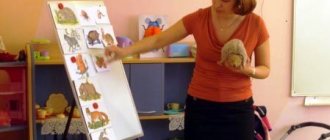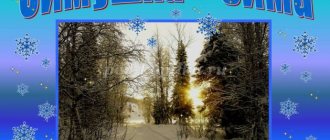Preview:
Municipal autonomous preschool educational institution
city of Naberezhnye Chelny “Combined kindergarten No. 23 “Firefly”
Summary of a drawing lesson in the preparatory group
Naberezhnye Chelny, 2016.
Arouse children's interest in late autumn, mosses growing on trees, stones, and forests, and develop the ability to be emotionally distracted by the mood of sadness conveyed in poetry. Arouse the desire to express this state with the help of color in a landscape drawing.
- practice naming autumn signs to enrich children’s vocabulary;
- form ideas about neutral colors (black, white, dark gray, light gray, brown), use these colors when creating paintings of late autumn;
- develop the ability to independently convey in a drawing the landscape of late autumn, its color (the absence of bright colors in nature);
- practice the ability to draw trees of different structures and bushes without leaves, draw growing moss on trees, stones and ground;
- consolidate drawing techniques with the end of the brush;
-continue to develop the ability to feel, understand and reproduce the imagery of the language of a poem;
- develop coordination of movements, accompanying speech;
— develop fine motor skills through finger play;
- cultivate a love for poetry and native nature;
- cultivate an aesthetic perception of nature;
— to cultivate in children an interest in drawings, a desire to look at and talk about them.
Sample made by the teacher. Landscape sheets of paper, watercolors, palette, brushes.
Reading poems by Russian poets about autumn by A. N. Pleshcheev, A. S. Pushkin, and others.
Memorizing poems about autumn “Autumn” by M. Khodyakov and “The Swallows Are Missing” by A. Fet. Poems about mosses.
A conversation about late autumn and its signs.
Examination of reproductions of paintings by famous artists in the presentation “Late Autumn through the Eyes of Artists.” Presentations about mosses.
Examination of illustrations, pictures, reproductions.
Observations (of the sky; trees; growing mosses: on trees, foundations, ground; rain; snow) while walking.
— Guys, what time of year is it now?
— What autumn months do you know? What month is it? November is the last month of autumn.
- Listen to A. Pleshcheev’s poem, what autumn is the poet talking about?
Withers and turns yellow
Grass in the meadows
A cloud covers the sky
The sun doesn't shine
The wind howls in the field,
—Are you happy about this picture painted by the poet?
— What signs of late autumn does Pleshcheev talk about in the poem?
- Indeed, the poem talks about a dull, gloomy, cold autumn. The leaves have fallen off the trees, the grasses wither and turn yellow, the bushes are dull and bare, the flowers have dried up, the birds have flown to warmer climes, and it often drizzles.
— Autumn is like the evening of the year. And in the evening we get ready for bed. So the trees took off their clothes and washed themselves with the rain. Wildlife falls asleep. Late, gloomy autumn has arrived. In late autumn there are often cold drizzling rains, sometimes snow or sleet, the trees shed their last leaves, the grass has dried up, the flowers have withered. The last birds fly south. Animals are preparing for winter, people put on warm clothes, moss continues to grow as it grows on trees, foundations, and the ground.
— The rain is knocking on our windows and inviting us to play.
A drop once a drop two. (Children perform jumps on two legs)
Very slowly at first, (Holding hands, children walk in a circle)
And then, then, then
Everybody run, run, run. (Walking in a circle with acceleration)
We opened our umbrellas, (We make a dome over our heads with our hands)
Sheltered herself from the rain. (Squat down)
- Today I invite you to draw late autumn. What colors will you need for this - warm, bright or cold, gray?
— Look at the picture depicting late autumn. What color is the sky? - What trees?
— What signs of autumn are depicted? (light snow, gloomy sky, there are no leaves on the trees, but moss grows on the trunk and branches on stones and ground).
— Now I’ll tell you how to get these dim colors. You have palettes on your tables; artists use these palettes to compose paints. And you, like real artists, will do this.
— What paint do we need to mix to get gray paint? (add a drop of black to white paint).
— Yes, to get gray paint you need to add a little black paint to the white one. If you are painting clouds, then take blue paint and add a little black and white paint to it, mix them on the palette. The color of leaves and grass in late autumn also lost its brightness - it is brown. Take green paint and add a little yellow and brown to it - you get a brown color.
- So, first you need to make up the desired paint on the palette, and then draw with it on the sheet.
Attention! Promotion until January 14!
Author: Butylchenkova Tamara Alekseevna Planning educational work in a group. Theme of the week: “Late Autumn”. Goal: To consolidate children’s knowledge about the signs of late autumn, remember poems, proverbs and sayings about autumn, develop observation skills, and activate vocabulary on the topic. Expand children's understanding of the features of displaying autumn in works of art.
date mode Integration of education areas Joint activities of adults and children, taking into account the integration of educational areas Creation (organization) of a developing subject-spatial environment for independent activities of children and support for children's initiatives Interaction with parents/social partners Educational activities in special moments (group, subgroup) Individual Topic week: “Late autumn!” Monday 09.11.2020 morning Social-communicative, cognitive, speech, artistic-aesthetic, physical Morning reception of children. Charger. Conversation “Late Autumn”: Purpose: to introduce the signs of late autumn using the example of paintings - landscapes on an autumn theme. D\\game “When does this happen?” Purpose: To expand children’s knowledge about autumn. Ecological fairy tale - conversation “The Adventures of the Wind”. Goal: to concretize and consolidate knowledge about wind. D/i “Which one, which one, which one?” Goal: to teach how to select definitions that correspond to a given example, phenomenon Storytelling from the collective experience “A Walk in the Forest” Goal: to clarify children’s ideas about the seasons; develop storytelling skills from experience. Talk with parents about the well-being of their children. Talk with parents about the well-being of their children. Main educational activity 1. Cognition (1-3 weeks. Life safety / 2-4 weeks. socialization). L. L. Mosalova (p. 54). Topic: “My address.” Goal: To consolidate children’s knowledge about the place of residence. To teach children to correctly compose a story, convey the content in an interesting way for others, and navigate on a piece of paper. 2.Physical education.L. I. Penzulaeva (p. 36). Topic: “Lesson 31.” 3. Artistic and aesthetic development. N. N. Leonova (p. 256) (1-3 weeks sculpting / 2-4 weeks applique). Topic: “Still life of fruit (apple, pear, grapes on a plate).” Goal: Learning to cut out round and oval objects, familiarization with still life. Walk 1 Observation of the sky and clouds. Goal: continue to consolidate knowledge about inanimate natural phenomena; clarify the concept of “Cloud”. D/and game “What is the sky?” Purpose: to practice selecting relative adjectives. P/n “The sea is agitated.” Goal: to develop imagination, the ability to express a conceived image in movement. Ind. zan. in physical training with Artem and Maxim. Exercise: jumping into and out of a circle made of leaves. Outdoor games "The third wheel". Objectives: teach to follow the rules of the game; develop agility and running speed. “Owl”. Goals: to teach how to navigate in space; develop interest in the game. Drawing with sticks on the sand. “Classics”. Evening Gradual rise of children, invigorating gymnastics, walking along the massage path. Self-care after nap. Goal: to teach how to dress independently and consistently. Reading poems about autumn Goal: developing perseverance, attention, broadening one’s horizons Conversation on the topic: “If the doorbell rang.” Goal: to generalize and consolidate children’s knowledge about safe behavior in cases where it is and is not possible to open the door to an apartment or house. S/r game “Hairdresser” “Smart lacing” Goal: development of fine motor skills, imagination Strengthen the ability to stroke in one direction Emilia, Ksyusha D/ and “Whose supplies?” Goal: to consolidate knowledge about preparing animals for winter. P/i “The squirrel chooses a hollow.” Purpose: to introduce Finnish outdoor games; interest children. Involvement in collecting material and designing albums on the topic. Drawing with stencils “Leaves”. Hatching in various directions. Walk 2 Observation of clothes in autumn (why people choose certain items) P/n “Find yourself a mate”, “We are funny guys”, “hit the target” Labor: preparing land for planting in winter Folk game “Fox in chicken coop." Goal: development of speed of movement. Sasha, Misha. Independent play activities of children with external materials. Goal: to teach how to find activities based on your interests, to play together, to educate friends
date mode Integration of education areas Joint activities of adults and children, taking into account the integration of educational areas Creation (organization) of a developing subject-spatial environment for independent activities of children and support for children's initiatives Interaction with parents/social partners Educational activities in special moments (group, subgroup) Individual Topic weeks: “Late autumn!” Tuesday 11/10/2020 morning Social-communicative, cognitive, speech, artistic-aesthetic, physical Morning reception of children. Charger. Conversation on the topic “Paintings by artists who painted autumn.” Goal: to consider reproductions of artists who painted autumn landscapes, to learn to answer the teacher’s questions with complete answers, to develop an active vocabulary. P/i “Cap and Ball”. Goal: to teach how to play with non-standard physical education equipment. D/i “Gather the Harvest.” Goal: continue to teach the difference between vegetables and fruits, cultivate respect for agricultural work. S/r game “Hospital” “Mosaic”, “Collect beads” Purpose: development of fine motor skills, thinking “Describe the toy” Purpose: to practice selecting adjectives. Artem V. Daniil D/i “Whose supplies?” Goal: to consolidate knowledge about preparing animals for winter. P/i “The squirrel chooses a hollow.” Purpose: to introduce Finnish outdoor games; interest children. Individual conversations and consultations at the request of parents. OOD 1.Physical culture.L. I. Penzulaeva (p. 37). Topic: “Lesson No. 32.” 2.Cognition (FEMP).E. V. Kolesnikova (p. 45). Topic: “Lesson No. 11.” Goal: Guess a mathematical riddle, write down the solution using numbers and signs. Write the number 7. 3. Communication (speech development). V. N. Volchkova (p. 32). Topic: Reading works of art. “Stupid people quarrel, but smart people come to an agreement” (based on the work of S. Mikhalkov “Rams”; K. Tangrykuliev “Roosters”, E. Blaginina “Gift”). Goal: To continue to teach children to emotionally perceive poetry and understand its content and idea, to develop in children the ability to find a positive solution in conflict situations, to perceive friendly relations between children, to develop dialogical speech, and the ability to maintain a conversation. Walk 1 Observing the work of a janitor Objectives: to expand knowledge about the work of adults in the fall; cultivate respect for work. Outdoor games "Cat and Mice". Goals: continue to teach how to follow the rules of the game; intensify physical activity. "Corners". Goal: to improve agility and running speed. Development of movements. Goal: develop the skills of throwing a ball at a target. Artem G. Misha Situational conversation about the need to take care of your appearance and the cleanliness of your clothes. Outdoor materials: balls, rudders, turntables Prepare outdoor materials for games on the site.
Evening Gradual rise of children, invigorating gymnastics, walking along the massage path. Self-care after nap. Goal: to consolidate the ability to dress independently and help each other. S/r game “Barbershop” Role-playing game “Shop”. Goal: To consolidate the ability to come up with a plot, play it out, distributing roles and using attributes. Strengthen the ability to hatch in one direction Sofia Drawing using stencils “Leaves”. Hatching in various directions Emilia, Sofia T. Organization of the exhibition “Autumn in the Forest”: (drawings, crafts, clay sculptures). Walk 2 Observation of trees. S/r game “Journey to the Forest” - repeat the rules of behavior in the forest. Labor: cleaning up fallen leaves P/i “Don’t get caught.” Goals: practice running in different directions; develop slow and fast running. Drawing with sticks on the sand. Sofya K. P/i “Stop”. Goal: to train children in the ability to perform movements in accordance with the text.
date mode Integration of education areas Joint activities of adults and children, taking into account the integration of educational areas Creation (organization) of a developing subject-spatial environment for independent activities of children and support for children's initiatives Interaction with parents/social partners Educational activities in special moments (group, subgroup) Individual Topic weeks: “Late autumn!” Wednesday 11/11/2020 morning Social-communicative, cognitive, speech, artistic-aesthetic, physical Morning reception of children. Charger. D/s on ecology: “Air, earth, water” Purpose: to consolidate children’s knowledge about natural objects. Develop auditory attention, thinking, and intelligence. Intellectual games: "Nikitin's Cubes" Goal. help accelerate the process of development in preschoolers of the simplest logical structures of thinking and mathematical concepts D/i “Name a word with a given sound” Goal: development of phonemic hearing. Lera, Misha. “Navigating in the room” Goal: to consolidate the ability to navigate in space relative to oneself. Individual consultations upon request. OOD 1.Music (according to the plan of the music director). 2.Communication (literacy education).T. M. Bondarenko (p. 148). Topic: “Introduction to the sounds [w] and the letter Sh.” Goal: To introduce children to the consonant sound [w] and the letter Sh. Continue to teach children to determine the place of a sound in three positions, to teach how to add words from letters. 3.Cognition (natural world).P. N. Nikolaeva (p. 51). Topic: “How forest animals - the bear and the squirrel - prepare for winter.” Purpose: To give children the idea that the forest is a habitat for wild animals, the squirrel and the bear are adapted to life in the forest all year round, to develop in children ideas about the sequence of events in the life of forest animals - from summer to winter. Walk 1 Observation of viburnum Goal: continue to introduce children to viburnum. Note what changes happened to her in the fall. Outdoor games “Geese and swans”, “Mousetrap”. Goal: learn to run, holding each other, listen to the teacher’s signal. Practice balance. Development of movements. Purpose: to teach running long jumps. Maxim, Artem G. Labor activity Collecting poplar, viburnum, and willow leaves for autumn crafts. Goal: to teach how to carefully collect and distinguish leaves from different trees.
Evening Gradual rise of children, invigorating gymnastics, walking along the massage path. Self-care after a nap. Goal: to consolidate the ability to dress independently, see problems in appearance and correct them. Listening to musical works “Sounds of Autumn”. Goal: to learn to evaluate music by its character (sad, happy), what mood is created by listening to musical excerpts. Individual work with a subgroup of children on speech development. Goal: to consolidate the ability to write short stories on the theme “Autumn.” Emilia, Artem V, Sasha, Nikolay. Board games: “Paired pictures” for the development of visual memory, observation, the ability to distribute attention and find identical images. P/N: “For raspberries.” Goal: development of general motor skills, coordination of speech with movement.
Walk 2 Observing the weather The teacher asks the children riddles and asks them to answer questions. If they frown, frown, or burst into tears, there will be nothing left. (Cloud.) Glistens in the sun after the cold On the gray asphalt... (puddle). What changes have occurred in nature? What is the sky like? How often does the sun shine? Does it rain? P/ And “Catch up.” Goals: to learn to act quickly on a signal; cultivate friendships. P/n "Don't get caught." Goals: practice running in different directions; develop slow and fast running. Dima, Sasha P/i “Sly Fox”. Goal: to develop motor activity, auditory attention, reaction speed, running. date mode Integration of education areas Joint activities of adults and children, taking into account the integration of educational areas Creation (organization) of a developing subject-spatial environment for independent activities of children and support for children's initiatives Interaction with parents/social partners Educational activities in special moments (group, subgroup) Individual Topic weeks: “Late autumn!” Thursday 11/12/2020 morning Social-communicative, cognitive, speech, artistic-aesthetic, physical Morning reception of children. Charger. Caring for indoor plants at the environmental center. Goal: to consolidate the skills and abilities acquired previously. P/n “Who will jump further?” Goal: development of the ability to jump into the distance. Review the rules of safe behavior in the game Autumn Coloring. Exercise in comparing objects by shape and color Ksenia, Sophia K. Fostering a culture of behavior: “Be modest. What does it mean?". Develop an idea of modesty. Ecological fairy tale - conversation “The Adventures of the Wind”. Goal: to concretize and consolidate knowledge about wind. D/i "Harvest". Goal: develop coordination of words with movements. Individual consultation upon request. The joint work of children and parents to clean up fallen leaves.
OOD 1. Communication (speech development). T. M. Bondarenko (page 156). Topic: Storytelling from personal experience on the topic “Our Living Corner”. Goal: Teach children to talk about their impressions, develop the ability to select interesting content for a story. 2.Physical culture.L. I. Penzulaeva (p. 37). Topic: “Lesson No. 33.”
Walk 1 Observation of the sky and clouds. Goal: continue to consolidate knowledge about inanimate natural phenomena; clarify the concept of “Cloud”. D/and game “What is the sky?” Purpose: to practice selecting relative adjectives. P/n “The sea is agitated.” Goal: to develop imagination, the ability to express a conceived image in movement. P/i “Ducklings” Goals: to practice running in different directions; develop slow and fast running. Veronica, Ksenia. D/i “Yes - no” Goal: to consolidate knowledge about the rules of behavior in the forest. Place pictures of birds in a corner of nature.
Evening Gradual rise of children, invigorating gymnastics, walking along the massage path. D/i according to FEMP: “Find an object” Purpose: to learn to compare the shapes of objects with geometric patterns. Individual work on social and communicative development: situational conversation “Why you can’t burn dry leaves” Goal: to form ideas about the rules of behavior in the autumn forest. Introduce the characteristics of leaf fall. Consolidate knowledge of the models “Safe behavior in the autumn forest.” Maxim, Emilia. Story game: “Helpers” (children, under the guidance of the teacher, show with gestures how to help their mother, nanny: “sweeping”, “washing the dishes”, “wiping the table”) Reading: N. Sladkova “Sinichkina’s pantry” Purpose: continue to introduce children to autumn works, develop children’s ability to listen carefully to the text, answer questions, and recite passages they like.
Walk 2 Observation of the soil. Goal: invite children to find the first signs of autumn. P/game of children's choice. Goal: teach children to negotiate and make choices.P.i. "A bird without a nest." Goal: to develop interest in outdoor games, the ability to coordinate one’s actions with friends. P/N “Who will throw next?” Goal: to develop coordination of movements, the ability to impart force to a throw. Daniil, Sasha P. and. “Quickly take it, quickly put it down.” Invite the children to tell the rules of the game, explain how the players need to act, appoint a judge who will monitor compliance with the rules. Strengthen the child's body.
date mode Integration of education areas Joint activities of adults and children, taking into account the integration of educational areas Creation (organization) of a developing subject-spatial environment for independent activities of children and support for children's initiatives Interaction with parents/social partners Educational activities in special moments (group, subgroup) Individual Topic weeks: “Late autumn!” Friday 11/13/2020 morning Social-communicative, cognitive, speech, artistic-aesthetic, physical Morning reception of children. Charger. Working in a corner of nature: observing indoor plants. We correctly name the above-ground and underground parts of the plant, compare plants by appearance, and talk about the rules for caring for familiar plants.D.i. “Find a player.” We find a player based on the description of clothes, give reasons for our choice, and compose descriptions ourselves. Duty in a corner of nature. Watering plants Goal: update knowledge Artem V, Veronica. about the rules and techniques of caring for plants. Ecological fairy tale - conversation “The Adventures of the Wind.” Goal: to concretize and consolidate knowledge about wind. Individual conversations and consultations upon request. Talk with parents about the possibility of meeting children on weekends
OOD 1.Reading fiction.O. S. Ushakova (p. 119). Topic: Small folklore forms. Compilation of fairy tales using proverbs. Goal: To consolidate knowledge about the genre features of works of small folklore forms (nursery rhymes, songs, riddles, proverbs, proverbs). 2. Artistic and aesthetic development.N. N. Leonova (p. 77) (drawing). Topic: “International Music Day”. Purpose: Depicting impressions of the holiday. 3.Music (according to the music director’s plan). Walk 1 Observing the sun, changes in illumination during the day, the length of the day. Goal: to help discover connections between certain signs of weather, seasonal changes in the life of flora and fauna, and the influence of the sun on living and inanimate nature. “Catch the ball”, “Crucian carp and pike”. Goals: continue to teach how to independently agree on the distribution of roles; practice the ability to catch and pass the ball, follow the rules of safe behavior when playing with the ball. Nikolay G. D/i “Which tree is the leaf from?” Goal: to consolidate knowledge about different types of trees, to learn to correlate leaves and trees. Situational conversation: “If there is no traffic light.” Strengthen the skills of safe behavior on the road. Evening Gradual rise of children, invigorating gymnastics, walking along the massage path. D/i "Harvest". Goal: develop coordination of words with movements. Reading poetic works. “Sad time, charm of the eyes...”. P/n “Listen to the claps.” Goal: development of attention, memory, reaction speed. Maksim . “Wellness moment.” Conversation “Children drink milk.” Goal: to develop children's ideas about healthy and harmful foods. Walk 2 Observation: flower garden in November. Invite the children to look at the flower garden, tell what changes have happened to the plants. Tell children about how various plants overwinter. P. and. “Who is faster.” Goal: Correctly perform the basic movements when running and jumping. Develop agility and reaction speed. P.i. "Mice and cat." Complications: running from the heel by rolling over the entire foot and moving to the toe; change in direction and pace of movement. Lera, Emilia. Independent motor activity. To develop children's creativity in motor activities, to intensify interest in it, to teach them to comment on movements, and to choose a plot for games.
LATE AUTUMN senior group.docx






